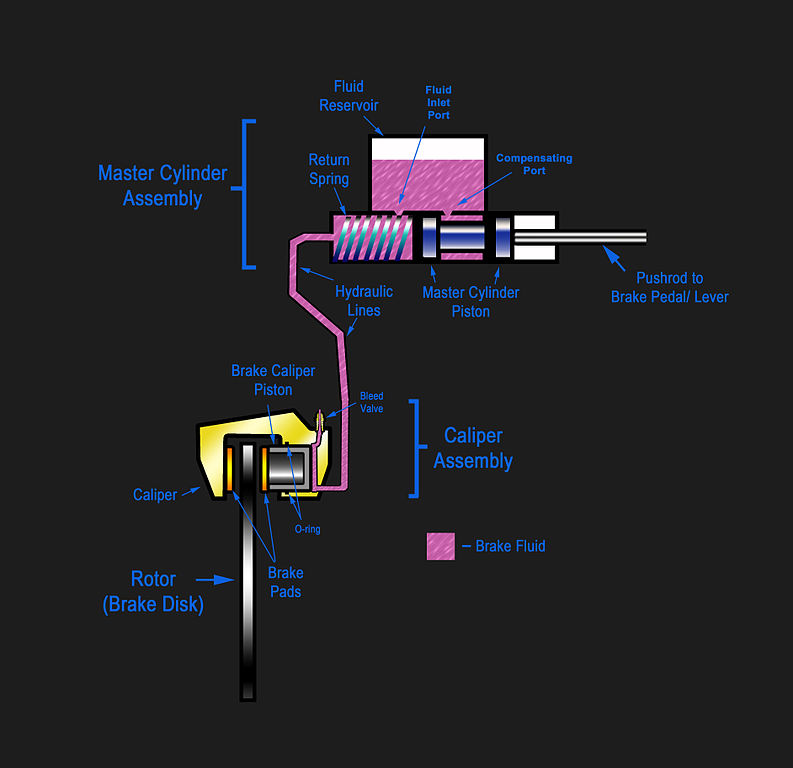 Your car’s braking system is one of the most important components of your vehicle. Every driver relies on their brakes to get their vehicle to come to a complete stop from speed. You depress the brake pedal and the car slows down, simple enough, right? What most drivers don’t realize is that the vehicle’s braking system is more complicated than they realize.
Your car’s braking system is one of the most important components of your vehicle. Every driver relies on their brakes to get their vehicle to come to a complete stop from speed. You depress the brake pedal and the car slows down, simple enough, right? What most drivers don’t realize is that the vehicle’s braking system is more complicated than they realize.
How they work:
A vehicle’s braking system uses friction in order to decrease the speed at which it is moving. It does this by making use of a combination of systems and components. When you depress the brake pedal, you are essentially creating friction between a non-moving object and a moving one. Here, the non-moving objects are brake pads and the moving objects are brake rotors, which move with the wheels, tires, and axle. When enough fiction has been created, the vehicle slows to a halt.
Hydraulic System:
Modern vehicles use a hydraulic system to help with brake pedal pressure. The hydraulic system in your car uses brake fluid to create increased pressure on the brakes. This system is used to alleviate the force needed on the brake pedal. It works like most other hydraulic systems. When the brake pedal is depressed, it moves a master cylinder piston to create pressure in a closed system through a network of lines to your brake calipers, thus creating enough force to push out pistons in your brake calipers, and additionally brake pads, ultimately creating friction against the brake rotor and slowing the vehicle down.
Brake Boosters:
Theoretically, depressing the brake pedal to slow a two ton vehicle should be very difficult due to the weight of the car. However, modern vehicles are equipped with what is called a brake booster in addition to its hydraulic system to assist the driver in braking.
A brake booster simply takes the amount of force that is applied to the brake pedal and multiplies it to the actual brakes itself. Therefore, the pressure that is forced upon the pedal is light and effective, rather than heavy and uncommunicative. A vehicle’s braking system is normally independent of other components of the vehicle, including the engine, except for the case of brake boosters. Brake boosters employ additional force to a vehicle’s brakes through the use of the engine’s vacuum. The vacuum that is created in your engine’s intake manifold is used by the brake booster to provide consistent, reliable braking assistance. Diesel engines do not have a vacuum and instead, use another means of brake boosting called hydroboost. A hydroboost system is very much like a vacuum system, but rather than using the vacuum from the engine, it uses the fluid from a vehicle’s power steering system for brake assistance.
Braking Electronic Assists:
The Anti-Lock Braking System, also known as ABS, is a system that has become standard on all new cars. What anti-lock brakes provide is the assurance that your vehicle’s wheels will not lock up. Having wheels that don’t lock up mean your car’s tires don’t slide against the road during hard or emergency braking. The main benefit of this is a shorter stopping distance. Studies have shown that such a system reduces a significant percentage of crashes.
Maintenance
Braking is such an important part of your vehicle’s safety and maintaining your braking system should be a part of regular maintenance. The three main things to watch for pertaining to brake maintenance are your vehicle’s brake pads, brake rotors, and fluids. Check the wear on your brake pads and rotors regularly and every time you change tires. Worn out brake pads will increase stopping distances and warped brake rotors and/or drums will cause vibrations under braking. Also check to make sure the brake fluid reservoir is properly filled.
